Before you buy new tools or parts, take a closer look around your home. What if the rusty old junk in your shed or the forgotten scraps in your backyard could become your most valuable tools? Hardware salvage isn’t just about hoarding leftovers, it’s a treasure hunt where discarded nails, worn hinges, and broken tools hold hidden potential. Mastering it means unlocking a world of possibilities: saving money, cutting waste, and crafting reliable gear from what others overlook. Ready to turn trash into treasure and give new life to forgotten hardware?
What Exactly is Hardware Salvage?
We’ve all been through it. We’re fixing or building something and need a single nut bolt and washer to finish. We head to the hardware store and are stunned to find out that simple nut, bolt and washer is going to cost a few bucks. Worse, we often have to buy 10, 20 or more of them in a box. It’s maddening. But proactively salvaging hardware could be an interesting solution.
Another possibility is that hardware is simply unavailable due to a natural or manmade disaster. The stores are closed, hardware is sold out or twice the price or maybe the closest hardware store is 30 miles away. For all of those reasons the idea of hardware salvage is a good one.
It’s pretty simple. You take something apart that you don’t need or have any use for and save all of the hardware. It’s a somewhat gradual and accumulative approach, but if you stick to it you’ll find that over time you’ve accumulated quite a collection. How to restore and store that collection we’ll get into later, but you get the idea.
What Are You Salvaging?
Think about that hardware store aisle where all of the hardware is stacked in boxes or bins. You’ll see thing like nuts, bolts, screws, nails, washers, hinges, springs, hooks, in all sorts of styles, types and designs. That’s also where you’ll find the high price tags. Now all you have to do is find something held together with a lot of hardware and take it apart and save the hardware.
Hardware Salvage Sources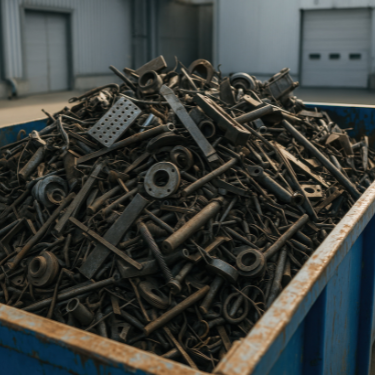
There are quite a few options for hardware salvage and if you’re actively doing this you may find more. Here are some of the obvious places to start.
√ Old, Broken Appliances
Before you pull that old washing machine, dryer, dishwasher or refrigerator to the curb -stop and think about the hardware inside. And while you’re at it, if you come across a lot of copper wire or copper tubing you can make some pretty good money at a junkyard. Copper prices keep going up.
√ Abandoned Vehicles
Welcome to the junkyard or anywhere else you come across a rusting, old abandoned vehicle. The vehicle itself may be a lost cause but the hardware holding it together is still functional. There’s a lot to think about when salvaging hardware from a vehicle from the usual nuts and bolts to fan belts, lightbulbs, wiring, even mirrors. And who knows, that old radio inside may still work if you connect it to a 12 volt battery.
√ Old or Abandoned Equipment
It doesn’t have to be a car or truck. Any kind of equipment is going to present its share of hardware for salvage and maybe some new things you wouldn’t expect. What you have to do is keep a salvage mindset and look at parts and pieces and wonder, “Will I ever need that.” The obvious caution is that hoarders often think that way so be realistic. Then again, you never know.
√ Old Cabinets and Furniture
When it comes to old cabinets and furniture it’s more about salvaging things like hinges, handles, knobs and other things that hold furniture together and make it work. It’s quite possible you might be building your own furniture someday, especially during tough times, and those nice hinges will still look very nice on your homemade table, dresser or cabinet.
√ Old Bicycles
You’d be surprised how much useful hardware is on something as simple as a bicycle. And this isn’t about pure hardware. In a time when gas prices are astronomical or not available, bikes may be a very popular source of transportation. In many parts of the world, it already is. The point is to think beyond the nuts and bolts and keep those good inner tubes, wheels, pedals or anything else you may need to repair a bike or even improvise one from multiple junked bikes. Here again, don’t overdo it. You eventually gotta store all this stuff and nuts and bolts and inner tubes are easier to store than a bunch of bike wheels.
√ The Amish Approach
One thing I noticed while learning about how the Amish build and repair things: they rarely ever buy new parts unless they absolutely have to. Salvage is second nature to them. When a tool breaks, they either fix it using parts they’ve saved over the years or repurpose something else entirely. No hardware store runs. No Amazon orders.
If you want to see how they do it, how they maintain everything from wagons to woodworking tools without electricity, this book on Amish ways is the best place to start. It’s full of resourceful, real-world solutions that work just as well today, especially if you’re trying to live with less dependency on outside help.
√ Abandoned buildings
Salvaging anything from an abandoned building can be both intimidating and dangerous. It could also be illegal. A lot depends on why the building was abandoned, who owns it and other factors you may or may not be aware of. But if you know the building is safe and for any reason considered useless or not worth protecting you might find some valuable hardware.
Thinks in terms of door hinges, door knobs, electrical outlets and switches (make sure the electricity is off), and just about anything else that presents itself as a hardware salvage opportunity. A good mindset is that if you can’t carry it out in your pockets or a small bag, leave it. If you’re walking out with a high value item and confronted, you’re not salvaging you’re looting. It’s worth thinking about it a bit before you saunter into an abandoned building.
√ Old doors and windows
The primary hardware on old doors and windows are the window locks, door hinges and knobs. Forget any doorknob that locks. You most likely wont find the key unless it’s one of those bedroom doorknobs you can open with a toothpick in a small hole on the other side. Windows could also present you with a nice pane of glass in case you have any broken windows to repair. Even if the window doesn’t have a chance of fitting, a glass cutter can make short work of any size piece of glass for a repair.
√ Home Center and Hardware Store Parking Lots
You may have noticed this the last time you went to a hardware store or home center. As you walk back to the car there always seem to be random washers, nuts, bolts and screws scattered here and there in the lot. That’s largely due to the fact that many tradesmen make frequent stops at these places and as they load or unload their trucks and vans, stuff falls out. That’s your opportunity to pick them up.
It won’t be a gold mine, but the next time you go to a home center or hardware store -take the time to scan the ground (or asphalt). You may be surprised how much you find particularly around the cart corrals for some reason.
√ Old Power Tools
All power tools eventually die or at least start malfunctioning. Before you toss it, cut that cord and wind it up. They’re usually heavy duty, heavy gauge cords with grounding plugs. You also might want to take it apart for any small screws and if you find a lot of copper wire around the motor -it’s worth salvaging.
√ Old electric and gas motors
Motors are held together with nuts and bolts, electric motors have lots of copper and grab that spark plug out of the old gas engine while you’re at it. It’s the same mindset. If it looks like you can use it someday, save it.
Managing your Collection
At some point it makes sense to sort through all this stuff and organize it some way. Baby food jars could be a place to start or one of those small drawer sets with the little plastic drawers. You could always do the old Mason jar sort and just dump out all the stuff you tossed in the Mason jar hoping you find what you need, but it helps to at least sort things by their type with wood screws in one container or drawer, bolts in another, nuts in another and on and on.
Tools for hardware salvage
Hardware salvage isn’t something you do with your bare hands. You need some tools. A ratchet, various sizes of pliers and vise grips, a hammer, wire cutters, even chisels and certainly screw drivers and an adjustable crescent wrench.
Restoring Hardware
A lot of this stuff will probably be rusty so soaking them in vinegar or a rust remover solution makes sense. They won’t look like new, but they’ll work better if you get rid of the rust.
What Can You Actually Build with Salvaged Hardware?
Once you’ve got a good stash of salvaged parts, the next question is: now what? The truth is, you’d be surprised what you can pull off with the right odds and ends. People have built chicken coop doors with salvaged hinges, cold frames for garden seedlings with old window hardware, and even hand-powered water pumps using little more than salvaged bolts, springs, and PVC pipe.
Need a manual grain mill because the power’s out? With the right salvaged hardware and a few scraps of wood or metal, that’s doable. Same with building a simple bike trailer, a rocket stove, or even a small wind-powered battery charger. None of that happens without a stash of random parts—and knowing what to do with them.
If you want to actually build off-grid solutions like those, using mostly what you already have, there’s a guide I always recommend. It’s called No-Grid Projects, and it walks you through some of the most practical, hands-on builds I’ve seen. You don’t need a workshop full of brand-new parts. Just some basic tools, a little grit, and the kind of hardware you’ve probably already got sitting in your garage.
The salvage Mindset
Once you start salvaging and collecting hardware you’ll start to see more and more new opportunities. It’s a salvage mindset that opens us up to the possibilities and the potential for many of those simple pieces of hardware we happen across. As time goes on you may be surprised how often you can build something or make a repair with your salvaged hardware. It’s another good step towards self-sufficiency and sure saves a lot of money for those simple nuts and bolts.
Off-Grid Tools You Should Look For At Flea Markets
75+ DIY Projects That Help You Survive Without Electricity (Video)
Amish Powerless Tools For A World Without Power
Here’s What You Need to Build a Forager’s Toolkit

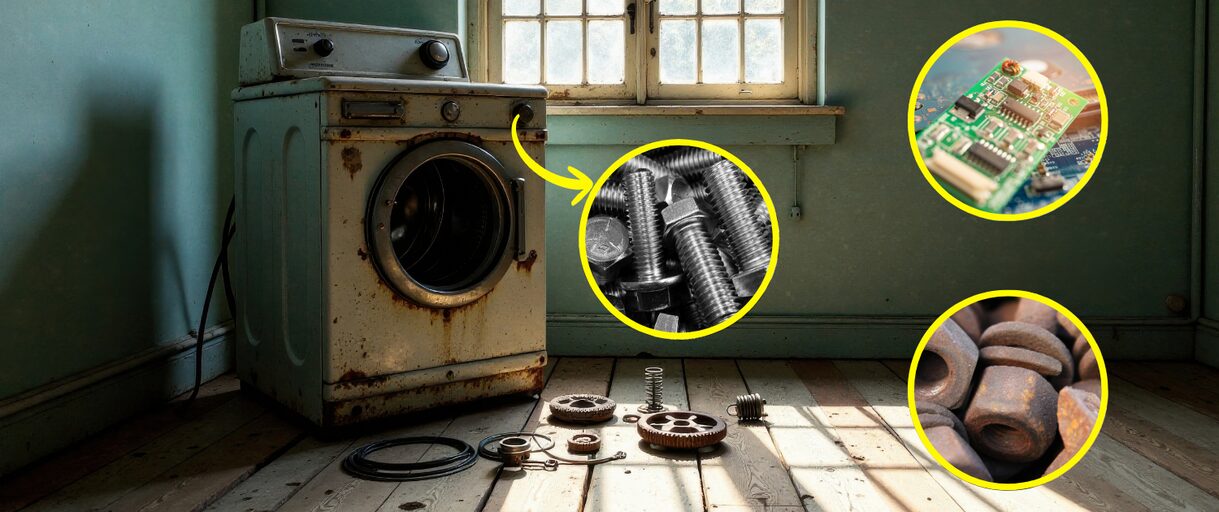
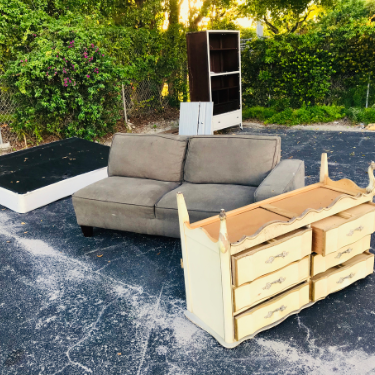

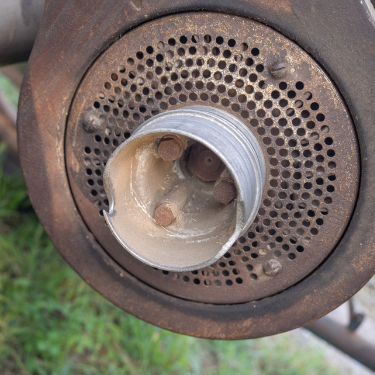
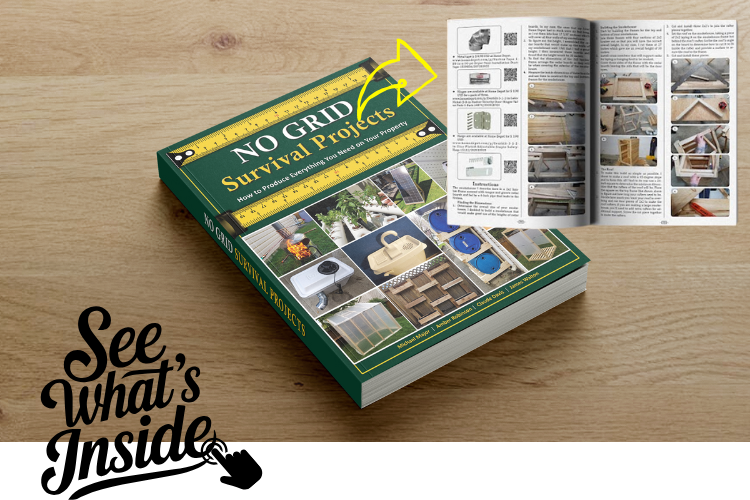



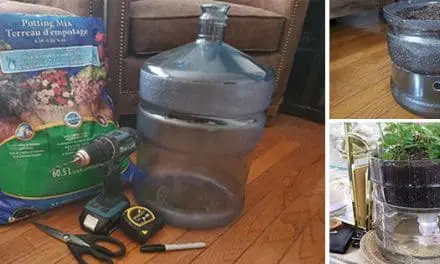

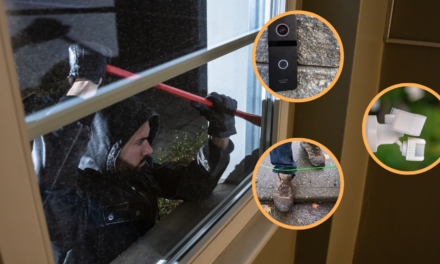







Those motors from electric dryers and washing machines are sought by DIYers who are trying to make some simple off-grid electrical generator system (using the motor in reverse, to generate power). I’m one, though my research right now is focusing on the aerodynamics of Venturis, which I expect will yield air flow sufficient to power my patent-pending revolving-door style wind turbine, under the name of Seraph Power.